Extremadura is a region in Spain that runs along side the Portuguese border, directly east of Lisbon, so in the central/west region of the country. From Lisbon it’s 200 km, or just a couple of hours drive away. We decided to do a short circuit tour of this region that would take us first to Merida in the south, then north taking in the towns of Cáceres, Trujillo and Plasencia, and then further up and then back west to La Alberca and Cuidad Rodrigo, before heading back to Lisbon.
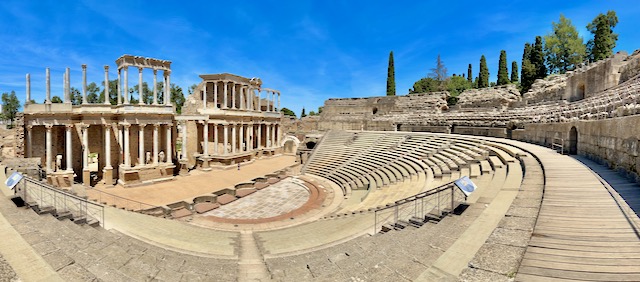
The first leg took us from Lisbon to Merida. Merida is best known for its Roman history and well-preserved Roman monuments, such as a theater (2,000 years old and still in use today), a coliseum, aqueduct and even a Roman circus. The theater remained hidden for 15 centuries, abandoned in the 5th century, under 8 meters of earth! It was not until 1910 that it was discovered, and it took another five years until they’d dug down far enough to located the stage.
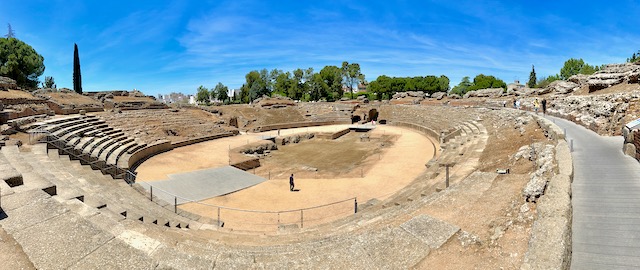
Actually there’s even more evidence of the Romans scattered throughout the city to discover. The streets in the historical district are narrow and meander, reminiscent of Seville, although not quite as flat. The river Guadiana runs through the town, with the longest remaining Roman bridge in Spain crossing it, now pedestrian only. Where the bridge enters the city lies the Alcazaba, a 9th century Muslim castle one can visit with the added benefit of viewing goldfish swimming in its underground water reservoir! If you are looking for a bit of Roman history, Merida is great. But the better medieval towns are to the north.


We left Merida and headed north to the Monfrague National Park, where the Palacio Viejo – Las Corchuelas hacienda/guest house/farm is located, and our accommodations for the next three days. It’s centrally located as a base to visit the other towns on our list, as well as to visit parts of the park. Las Corchuelas is mostly self-sufficient, with a large vegetable garden and lots of sheep, goats, cows, chickens and geese running around the property. Each night, as we sat down for dinner, we’d watch a parade of farm animals returning to the barn after a day of scavenging for food, knowing one of them could be dinner the next night! There’s a swimming pool and a pond in the back, as well as plenty of places for lounging. And, except for the baying of the sheep, very quiet. All of our meals were made or raised on the farm, from the meat dishes to the cheeses, vegetables and fruits.
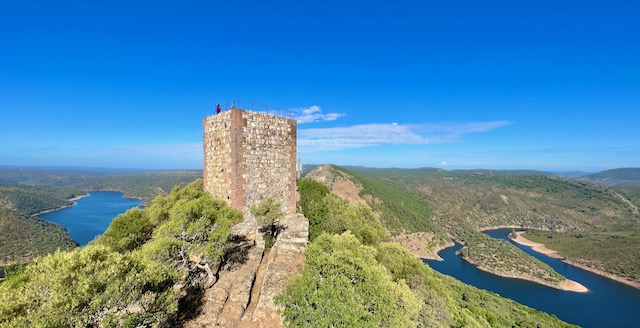
On our second day we drove up the mountainside behind us to a castle mount that overlooks the Tajo river and offers impressive, panoramic views of the park, river and countryside. The castle once contained five towers, but just two remain, built most likely by Arabs during the 7th century.
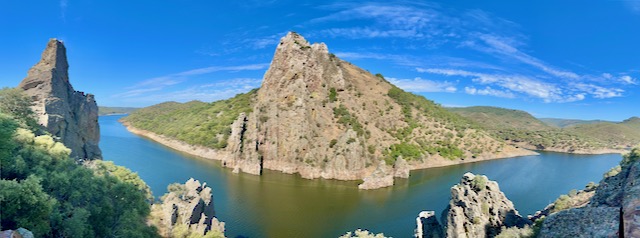
From there we drove down to the Salto del Gitano, two giant granite pillars that tower over the Tajo river. Wind currents circle the pillars and provide lift for numerous eagles that make this area their home, building theirs nests in the crooks and crannies of these majestic pillars. This makes it very popular with bird watchers, who line the look-out area with high-powered telescopes and cameras.
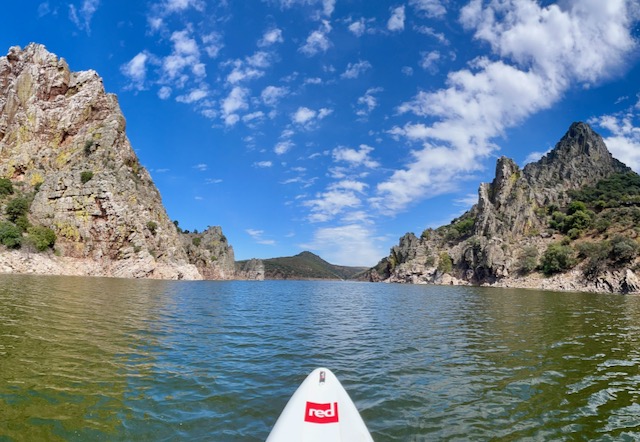
The river looked so enticing I took Flo back to the Las Corchuelas and then returned to inflate my paddle board and headed out on the water. I had the wind in my face going up river, but enjoyed a nice ride back as the wind helped me along. When I returned I was greeted, however, by three very mad park rangers. It seems that in Spain no one is allowed to swim, or navigate in any type of boat, not even a paddle board, on its waterways. They proceeded to give me a lecture on how I had endangered myself because rocks could have fallen on me, and I that I had bothered the eagles (even through they were flying 100 meters above me. My board was confiscated and I was told I’d be fined. They took down information about me, and my board, and sat they’d get back to me. I asked how I was supposed to know this, as there was no signage, (which they acknowledged), but said I should have asked at park headquarters first. It seems that someone at the lookout, where birdwatchers gathered, didn’t like me being out there and had called the emergency number on me. So, a warning, don’t go swimming, paddling or canoeing on the waterways of Spain’s national parks!
The next day we visited Trujillo and Cáceres, our two favorite Extremadura towns. They are well preserved, well taken care of, clean, and have a rich history. Most striking was the large and extravagant mansions and manor houses that can be found in these two villages, mostly gathered around the town square. These were built with the wealth many from this area accumulated from their voyages to the Americas in the 16th century, following men such as Francisco Pizarro and Hernan Cortes. It’s what makes these towns stand out from others in Spain at this time, the amount of wealth they once had and what was built with it.

Trujillo
Trujillo is the first stop on the Ruta de los Conquistadores, known by this name because it passes through the birthplaces of many illustrious characters tied to the discovery of America.
Trujillo is an excellent example of the wealth obtained by the conquistadors, with its elaborate manor houses centered in and around around the Plaza Mayor square. Trujillo origins date back to the Romans and Visigoths, and then for 500 years it was under Arabic dominion. But in 1232 it passed into Christian hands after being conquered by King Fernando III.

It was in the 16th century, however, that Trujillo experienced an age of great splendor due to its important role in the discovery of America. The city was the home of three great conquerors: Francisco de Pizarro, discoverer of Peru, Nuflo de Chaves, discoverer of Bolivia, and Francisco de Orellana, who was first to sail the length of the Amazon. The still city preserves its old flavor in its medieval village of Arabic origin, and the town that evolved from it in the 15th and 16th centuries.
But Trujillo is best known for its native son, Francisco de Pizarro, who spearheaded expeditions that (eventually) led to the Spanish conquest of Peru. With Vasco Núñez de Balboa he crossed the Isthmus of Panama and they became the first Europeans to see the Pacific Ocean from the Americas. He served as mayor of the newly founded Panama City for a few years and lead a campaign that led to, after a few attempts, the conquering of Peru by defeating and then executing the Inca Emperor Atahualpa.
History Tidbit: After Atahualpa’s execution, his wife, 10-year-old Cuxirimay Ocllo Yupanqui, was taken to Cuzco and given the name Doña Angelina. There, as Pizarro’s mistress she bore him two sons. A niece of Atahualpa, Francisca Yupanqui, would later marry Hernando Pizarro, Francisco’s brother, (and in essence her uncle), and they returned to Spain, very wealthy, and built and lived in a plateresque-style palace on the corner of the Plaza Mayor in Trujillo, now a recognizable symbol of the plaza. On its façade is a corner balcony with Plateresque decorations and two alabaster columns, topped by the coat of arms of Francisco Pizarro. As well, a bronze-cast sculpture now presides over the Plaza Mayor Square of Francisco Pizarro.

Above the Plaza Mayor, on top of the hill mount, lies a castle of Arabic origins, surrounded now by a park, providing panoramic views of the town and region. Trujillo is truly an enjoyable town to explore on foot, with information placards found in front of the many interesting historical buildings in the old town district.
Cáceres
Cáceres a UNESCO heritage site, is considered to be one of the most beautiful cities in Spain, (although I’ve heard that said about many other cities in the country!). But it really is special with its Roman, Moorish and conquistador architecture, surrounded by medieval walls, and numerous palaces with stork-topped watchtowers.

You feel a little like a time traveller walking its narrow cobbled streets, surrounded by opulent mansions and palaces. The old town is built around, (as most medieval towns are), the Plaza Mayor, an arcaded square full of life that’s surrounded by restaurants and cafes. The gateway to the plaza is the 18th-century Arco de la Estrella, a wide arch designed to once let horse-drawn carriages pass through.
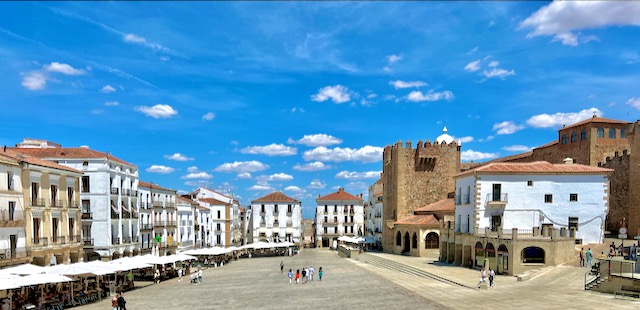
The most interesting mansion, just off Plaza Mayor, is that of Toledo-Moctezuma – as in the Moctezuma that once ruled Mexico. This story is too good not to tell, especially as Flo and I have a history with Mexico.
History Tidbit: With the fall of Moctezuma, his daughter, Doña Isabel Moctezuma (previously Tecuichpoch Ichcaxochitzin), was recognized by Hernan Cortés as Moctezuma’s legitimate heir and became one of the indigenous Mexicans by way of an “encomienda”, which is a right over a certain region, and the servitude, (or what amounted to slavery), of its people. Her encomienda was the largest encomienda in the Valley of Mexico, an indicator of the importance Cortés gave to Isabel.
She was first married very young to a general of her father, who died shortly after their marriage. She would go on to marry two Aztec emperors (Cuitlahuac and Cuauhtemoc), three Spaniards, and be widowed five times, all before she died at 41 years of age. In between she was a mistress of Hernan Cortés in which they had a daughter together. Juan Cano de Savedra, her last husband, held a relatively high position in Spain. One of their sons, Juan Cano de Moctezuma, returned to Spain where he not only obtained a final recognition of the Spanish Crown as the legal heir to Motecuhzoma and his inheritance, but the also married Doña Elvira de Toledo who belonged to one of the most aristocratic families in Spain, which then initiated the lineage of the Toledo-Moctezumas. In Cáceres he constructed the Palace of Toledo-Moctezuma, which survives in spite of all the political and natural cataclysms that Spain suffered in the past four centuries, and it can be found just off of the Plaza Mayor, overlooking the plaza. Final note: In Doña Isabel’s will she freed all the people that she held by right of the encomienda, releasing literally thousands of people out of slavery.
On our final days we visited Plasencia, but didn’t really find it exceptional, especially compared to Trujillo or Cáceres. One our way back to Lisbon we stopped at the border town of Badojaz for lunch, but again, nothing special was to be found here. The highlights for us of Extremadura were Merida, Cáceres, Trujillo and the Monfrague Park.
We were supposed to go on to La Alberca and then Ciudad Rodrigo, but we received a message from the hotel we were to be staying at, 24 hours before leaving, that the spa area of the hotel was going to be closed for 24 hours, exactly the time of our stay. And we had purposely chosen this hotel because of its spa, for our last night. As we couldn’t find anything else at such short notice, we just decided to return home and enjoy our jacuzzi on the terrace instead!


